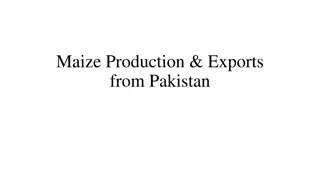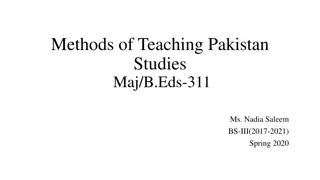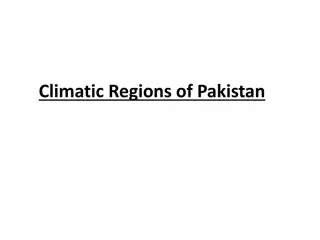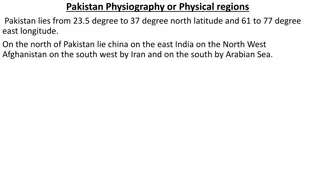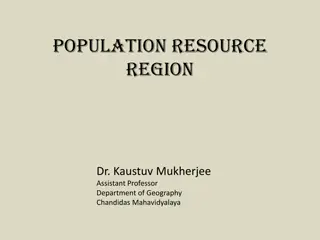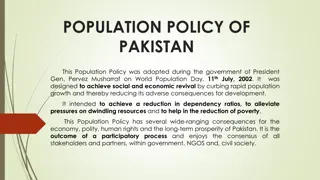Population Distribution in Different Regions of Pakistan
The population distribution in Pakistan varies significantly among different regions, with certain provinces like Punjab and Sindh having higher population densities compared to Baluchistan and FATA. The rural areas are also categorized into different population density regions based on the number of persons per square kilometer. This data provides insights into the uneven distribution of population in Pakistan, highlighting the challenges and opportunities in different parts of the country.
Download Presentation

Please find below an Image/Link to download the presentation.
The content on the website is provided AS IS for your information and personal use only. It may not be sold, licensed, or shared on other websites without obtaining consent from the author.If you encounter any issues during the download, it is possible that the publisher has removed the file from their server.
You are allowed to download the files provided on this website for personal or commercial use, subject to the condition that they are used lawfully. All files are the property of their respective owners.
The content on the website is provided AS IS for your information and personal use only. It may not be sold, licensed, or shared on other websites without obtaining consent from the author.
E N D
Presentation Transcript
Different regions of Pakistan on the bases of population
DISTRIBUTION AND DENSITY OF POPULATION OF PAKISTAN Introduction The distribution of population is refer to the number of people living in particular area. The area may be a district, province or a country Population Density. The total number of people living in a given area. It is calculated by dividing the population by the area. In 1998 the density of population of Pakistan are166 persons per square kilometer. Population distribution in Pakistan. Pakistan population is very unevenly distribution for Baluchistan constitutes about 47 percent of the total area of the country but only 5 percent of population lives there, on the other hand Punjab constitutes 25.8% of the total area of the country but 56% of population lives there.
Province wise population of Pakistan Province Area in % Population Population in % Population density in 1998 S,q km Punjab 25.8 73621000 56% 56 Sindh 17.7 30440000 23 23 KP 5.9 17736000 13 13 Baluchistan 47 6566000 5 5 FATA 3.4 3176000 2 2.4
Density of population in rural area. 67 % of the population living in the rural area in Pakistan. In 1951 the density of population in rural area was 35 persons per square kilometer. In 1981 this rose to 77 and in 1998 to 112. The rural area of Pakistan can be divided into the following population regions.
RURAL POPULATION DENSITY REGIONS RURAL POPULATION DENSITY REGIONS The ruler area of Pakistan are divided in to the following population regions Population density regions Definition Where it is found in Pakistan Thinly populated 10 or less persons 1. South western Baluchistan s area where rain fall is less regions sq, km than 250 millimeters, no irrigation facilities covered by plateaus, hills and mountains. 2. Northern area covered by large mountains and narrow valley, Moderately populated 11 to 50 persons Turbat and panjgur distt, of Baluchistan. The Chitral in regions per sq, km the northern parts of Pakistan. Densely populated 51 to 100 persons South eastern Baluchistan and western Punjab, Dadu and regions per sq, km Thatta in Sindh, Kohistan and Shangla districts in KP etc Very densely populated 101 to 200 person Parts of Indus valley in Sindh a large parts of western regions per sq, km Punjab the adjoining parts of KP and FATA and the swat valley. Most densely More the 200 Bari, Rechna and Chaj Doabs of Punjab, central Sindh and populated regions persons per sq, km central area of KP province.
URBAN POPULATION DISTRIBUTION IN PAKISTAN URBAN POPULATION DISTRIBUTION IN PAKISTAN The distribution of the urban population in Pakistan can be bitter understand if the cities divided into groups Larger Population 100000 or more Intermediate Population 25000 to 99999 Small Under 25000
SHARE OF URBAN POPULATION IN 1998 SHARE OF URBAN POPULATION IN 1998 Type f cities Share in urban population in 1998 In percent Larger 71.7 Intermediate 20 Small 8.3
In 1998 there were seven larger towns with a population of one million or more which accounted for about 50 percent of the total urban population of Pakistan. Population of 10 larger cities of Pakistan are shown in the table with their population
Cities Population (in thousands) Karachi 9269 Lahore 5063 Fasalabad 1977 Rawalpindi 1406 Multan 1182 Hyderabad 1151 Gujranwala 1125 Peshawar 988 Quetta 560 Islamabad 525
Factors influencing Population Distribution Density Factors influencing Population Distribution Density The density of population is unevenly distribution in Pakistan in some district the density drop to below 5% like in Chagai and Kharan while some district it rises above 500 person per square kilometer like Lahore and Sialkot etc. this uneven distrabuation of population is due to a variety of factors these factors area 1 Geographical Factors: 2. Economic Factors 3. Social/Cultural Factors
Geographical Factors 1 Availability of Water: It is one of the main factor which force people to settle in a particular area as water is used for drinking, crops growth, cattle breeding etc 2 Landforms: People prefer to live in plain areas as these areas are easy to access, and are feasible for communication, agricultural and industrial activities. 3 Climate: Another important factor for dense population in an area is climate. People prefer to live in areas which have moderate climate-thus avoiding extreme climates like that in Antarctica. 4 Soil: Most of the people who are linked with agriculture prefer to live in areas which are fertile.
Economic Factors Economic Factors 1 Urbanization: Better job opportunities, education and health facilities are also responsible for dense population in a limited area. Urban cities are densely populated as it has all these facilities. To name a few, Tokyo, London, New York, Dubai are some of the famous cities in the world. 2 Minerals: Areas rich in minerals attract people interested in mining activities and thus companies of international standard which in turn attract people in search of jobs thus increase in population of that area. 3 Industrialization: Industries not only require labors but also operators, management staff, engineers, doctors etc as it has its own residential area. 4 Need for High Income: Farmers in agricultural areas require larger work force to increase crop yield and income. They do not think about increased population
SOCIAL/CULTURAL FACTORS SOCIAL/CULTURAL FACTORS 1 Religious-cultural Factors: Islam and Christianity strongly criticize family planning therefore; people who are very religious minded do not care for increased population. People try to live at places where people of same culture are present. 2 Lack of Education: Lack of education is also one of the greatest factors of increase in population as people are unaware of the economic burden, increased population put on country s economy. 3 Government Policies: Frequent government changes results in inconsistency of policies against high population growth rate. The government of France now gives incentives to the parents for giving births to more children as their population growth rate is now negative. 4 Age of Marriage: In the Least Developed Countries (LDCs), females get married at very young age and this also contributes to high population growth in Least Developed Countries.
SOCIAL/CULTURAL FACTORS SOCIAL/CULTURAL FACTORS 5 Wish for a Boy: People also wish for a baby boy who would be a source of income for the parents in their old age. In wish of a boy, sometimes people have more daughters as well. 6 Decrease in Death Rate: The advanced medical facilities have caused decrease in death rate which has also contributed to the increase in population density. 7 Political Unrest or War: Areas which are involved in war or are experiencing political unrest, people tend to move from that areas which result in less population at one and increase in another area.





